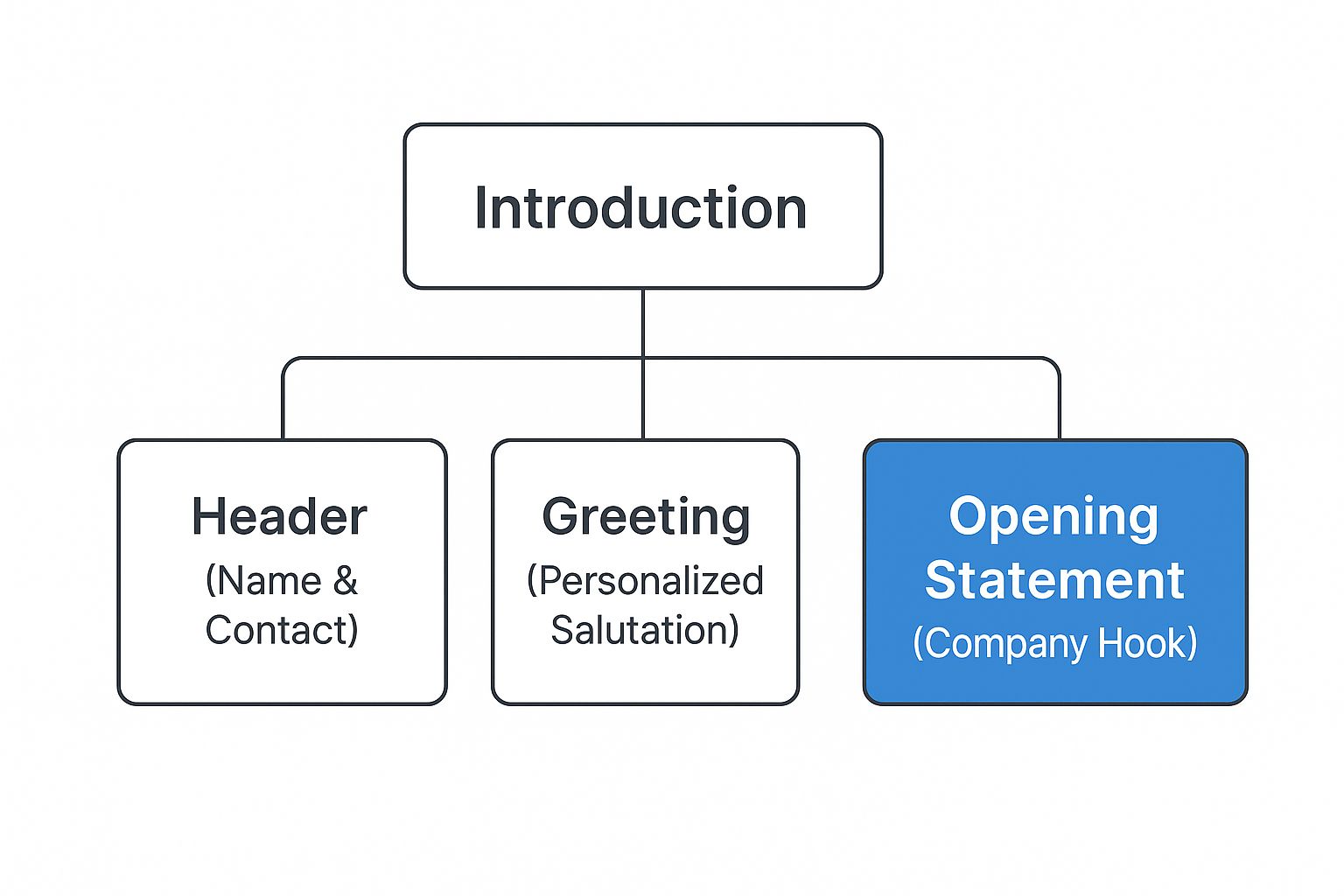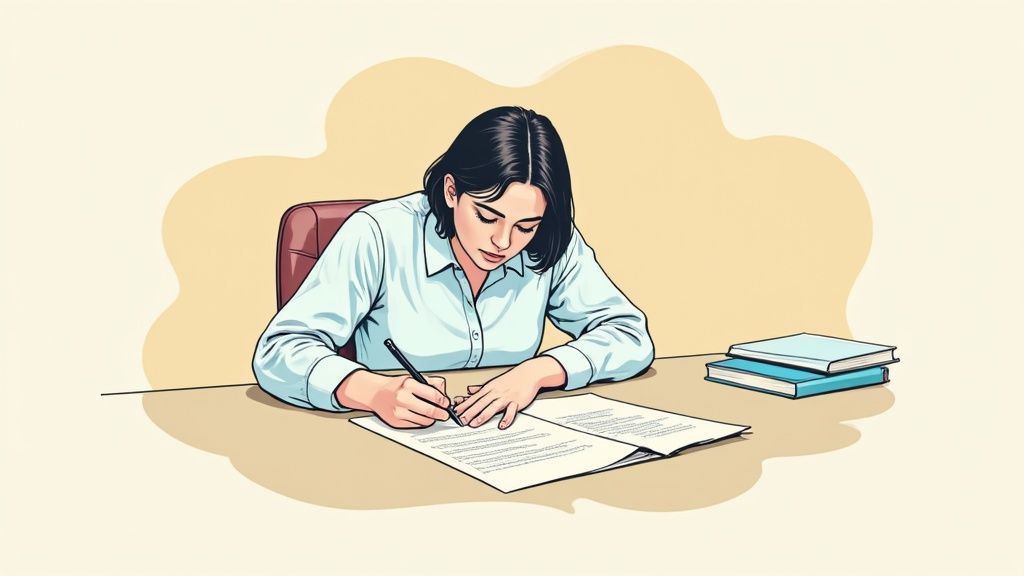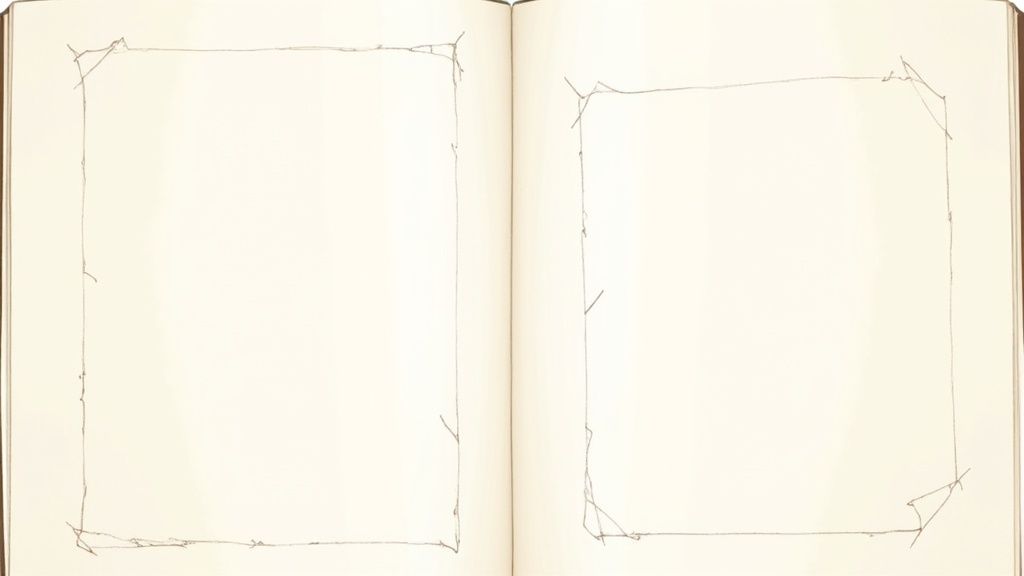What Should a Cover Letter Include to Get You Hired?
- Alex Khamis

- Oct 6
- 8 min read
Updated: Oct 12
Think of your cover letter as a conversation starter, not a formal document. It’s your first real chance to show a hiring manager who you are beyond the bullet points on a resume.
To make that conversation count, you need a solid structure. An effective cover letter has seven key parts. Get these right, and you'll connect your experience directly to the job you want.
The Real Anatomy of a Cover Letter That Works
Let's cut the corporate jargon. Your cover letter is your handshake and elevator pitch rolled into one. It’s your argument for why you’re the solution to their problem. Forget the tired templates.
For a deeper dive, explore our other cover letter guides. But the core roadmap is always the same.
Here are the seven non-negotiable parts:
Header: Your contact info, clean and simple.
Greeting: Addressed to a real person, not a title.
Introduction: A powerful opening that hooks them fast.
Body Paragraphs: The proof. Connect your skills to their needs.
Company Fit Paragraph: Shows you’ve done your homework.
Call to Action: Confidently asks for the interview.
Signature: A clean, professional closing.
This isn’t just about following rules. It shows a recruiter you're organized, thoughtful, and serious. The infographic below breaks down how crucial that opening is for setting the right tone.

As you can see, a strong start isn’t just one thing. It’s three elements working together to grab and hold the reader's attention.
To see how these parts create a powerful story, check out this a comprehensive guide to crafting a cover letter. Mastering this structure moves your application from the “maybe” pile to the “must-call” list.
Essential Cover Letter Components at a Glance
Sometimes you just need a cheat sheet. This table cuts the fluff and gives you the real purpose of each component.
Component | Its Real Purpose (No Fluff) |
|---|---|
Header | Makes it easy for them to contact you without digging around. |
Greeting | Proves you did your homework and aren't just spamming applications. |
Introduction | Hooks the reader and answers their first question: "Why should I care?" |
Body Paragraphs | Gives concrete proof that you can solve their specific problems. |
Company Fit Section | Shows you get their mission and aren't just looking for any job. |
Call to Action | Confidently tells them the next step is an interview. |
Closing | Ends things on a professional and polished note. |
Think of these as building blocks. Each one supports the next, creating a solid argument for why you're the right person for the role. When they work together, your cover letter feels less like an application and more like the start of a conversation.
Nailing Your Header and Greeting
This part seems basic, but it’s the first place hiring managers spot laziness. Your header isn’t a formality; it needs to be clean, professional, and make you easy to contact.

Get the basics right. Full name, phone number, and a professional email are mandatory. Add your city and a link to your LinkedIn profile. It's standard practice for a reason. Get tips on adding your LinkedIn URL to your resume.
Your Professional Header
Your header should present this key info cleanly. No clutter.
Your Full Name
City, Province (No need for a full street address.)
Phone Number
Professional Email Address
LinkedIn Profile URL (Customized, not the default numbers.)
Beneath your details, add the date and then the company's information. That means the hiring manager's name, their title, the company name, and its address.
Let’s be blunt. "To Whom It May Concern" is a massive red flag. It screams that you didn't do the bare minimum research. It makes your letter feel like junk mail.
The Art of the Greeting
Finding the hiring manager’s name takes five minutes on LinkedIn or the company website. That tiny effort immediately sets you apart from the crowd and shows real initiative.
Once you have the name, keep the greeting professional. Stick with "Dear [Mr./Ms./Mx. Last Name]." It’s respectful, traditional, and gets straight to the point.
The little details matter. Use a standard business font between 10–12 points. Including the hiring manager’s name in both the address and the greeting makes it far more likely your letter will be read.
Writing an Introduction That Hooks Them Immediately
Your first paragraph has one job: make them read the next one.
Honestly, opening with “I am writing to apply for the Project Manager position” is the fastest way to put someone to sleep. They already know that. It's in the subject line.
That kind of opening screams “generic template.” Your goal is to prove, right away, that this letter was written for this company and this role. This is how you separate yourself from 90% of other applicants.
Connect Your Passion to Their Work
The best introductions prove you did your homework. Mention something specific about the company—a recent project, a core value you admire, or a new product launch that caught your eye.
Here are a few practical ways to craft a compelling opening:
Mention a success: "When your new XYZ platform launched last quarter, I was impressed by your team's approach to solving [specific problem]."
Align with their mission: "I’ve followed [Company Name]'s commitment to sustainability for years. Your recent B Corp certification inspired me to apply."
Show industry awareness: "After a decade managing logistics in the SaaS space, I was drawn to the Senior Manager role and its focus on optimizing your international distribution network."
The point isn’t flattery. It’s creating an immediate, relevant connection. A strong opening shows you don't just want a job; you want this job.
This storytelling approach is also great for crafting strong LinkedIn summary examples. A brief story makes your experience far more memorable.
Proving Your Value in the Body Paragraphs
Okay, this is where the real work happens. The intro hooked them; now the body has to deliver the proof.
This isn't the place to just rehash your resume. Let's be blunt: nobody wants to read a list of your duties. They want to see results.
Think of each body paragraph as a mini case study. Connect a specific skill you have to a pain point from the job description. Don’t just say you have a skill. Prove it with a clear example.
From Vague Claims to Concrete Proof
The difference between a weak and a powerful body paragraph is simple: numbers.
Vague statements like "I am a strong team player" are meaningless. They sound nice but offer zero substance. Instead, you need to show, not tell. Frame your wins with data.
For example:
Weak: "I helped with the marketing campaigns."
Strong: "I spearheaded a digital marketing strategy that grew qualified leads by 32% in six months, boosting quarterly sales by 15%."
See the difference? The second example uses hard evidence to prove you understand business impact.
The Problem-Solution Formula
A simple, effective structure is the problem-solution formula. Identify a need from the job ad, then tell a quick story about how you solved a similar problem in a past role.
Your cover letter is an argument for why they should hire you. The body paragraphs are your evidence. Each one should make the hiring manager think, "This person gets our problems and can fix them."
If the ad wants someone to "streamline inefficient processes," describe how you audited a workflow and implemented a system that cut project delivery times by 20%. That’s how you demonstrate real value.
Learn more about framing your wins in our guide on how to present your resume accomplishments.
Closing With a Confident Call to Action
You’ve built a strong case, so don’t fumble the ending. A weak closing like, "I look forward to hearing from you," is passive. It puts the ball entirely in their court.

A proactive closing shows confidence. You just proved your value. Now it’s time to confidently propose a conversation about putting that value to work for them.
Proposing the Next Step
The goal is to be assertive without being arrogant. You want to reiterate your interest and make it easy for them to say "yes" to a conversation. This directs their focus to scheduling an interview.
Instead of just hoping they call, state your intention clearly:
Show enthusiasm: Briefly restate your excitement for the role.
Suggest a meeting: Propose a direct conversation to dig deeper.
Provide availability: Mention you're available for a call next week.
A strong closing isn't just a polite sign-off; it’s a strategic move. You're concluding your argument by clearly stating what should happen next: a real conversation.
Examples of Strong Closings
Let's look at this in practice. A weak closing is passive. A strong one is confident.
Avoid this passive approach: "Thank you for your time and consideration. I hope to hear from you soon."
Instead, use a confident call to action: "I am excited about the possibility of contributing to your team and am available for an interview next week. Thank you for your time and consideration."
This confident tone should carry over into any follow-up. For more on that, see our guide on what to say when emailing a resume.
Finally, wrap it all up with a professional sign-off like "Sincerely" or "Best regards," followed by your full typed name.
Common Cover Letter Questions Answered
Even with all the pieces in place, a few nagging questions can throw you off. Let's tackle the most common ones with direct, no-nonsense answers.
Does Anyone Actually Read Cover Letters?
Let's be blunt: yes, but not always. Think of it as a tiebreaker.
A great cover letter can save a borderline resume. But a lazy, generic one will sink a strong application. It’s your best chance to show personality and connect the dots.
Many use it as a filter. It quickly shows who is genuinely interested in this specific role versus who is just firing off applications. It's your opportunity to prove you did your homework.
How Long Should a Cover Letter Be?
One page. Period.
Seriously. Aim for three to four short paragraphs, which usually lands you in the 250-400 word range. Anything longer suggests you don’t respect the reader's time.
Recruiters review hundreds of applications. They won't read a novel. Make your point quickly, provide your evidence, and get out. Every sentence must have a purpose.
Remember, the goal isn't to tell your life story. It's to build a case that convinces them to invite you for an interview.
Can I Use AI to Write My Cover Letter?
Using AI is fine for brainstorming or fixing grammar. But never just copy and paste what a tool like ChatGPT spits out. Recruiters are getting good at spotting generic, robotic text.
Here’s how to use it smartly:
Brainstorming: Ask for ideas for opening hooks or ways to phrase a win.
Structure: Use it to create a basic outline from the job description.
Polish: Paste your own draft into it and ask for grammar suggestions.
Your voice, your stories, and your real enthusiasm are what make a cover letter work. AI can’t fake that. The final product must be heavily edited to sound like you.
Crafting a document that hits all these marks can be challenging. If you want to ensure your cover letter and resume are perfectly aligned to land you that interview, the experts at Final Draft Resumes are here to help. Learn more about our professional writing services.
Author
Alex Khamis is a Certified Professional Resume Writer and Managing Partner at Final Draft Resumes and Resumatic.
He has over 15 years of experience across career services and business communications. He's helped people land roles at companies like The Walt Disney Corporation and Microsoft.


Comments